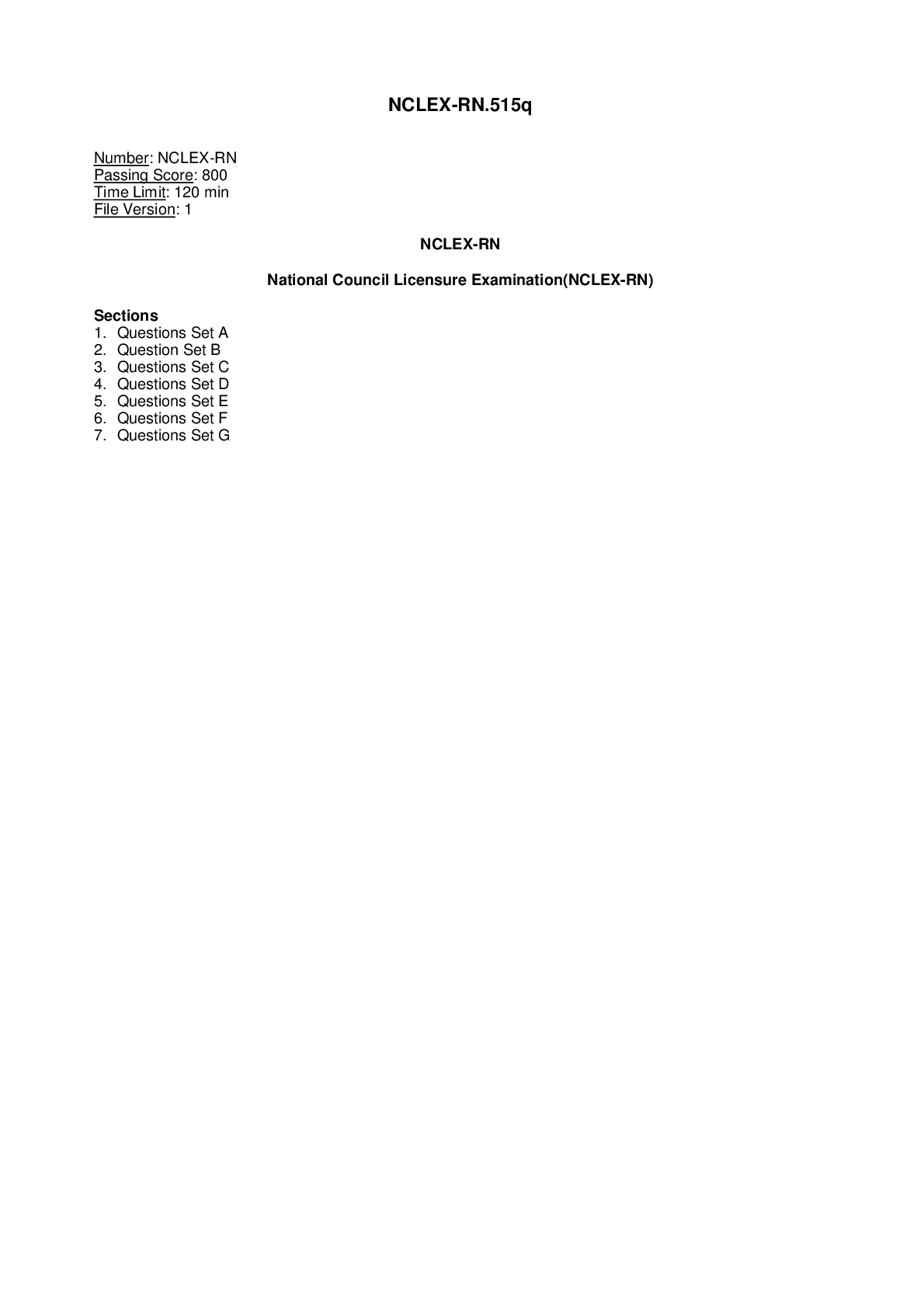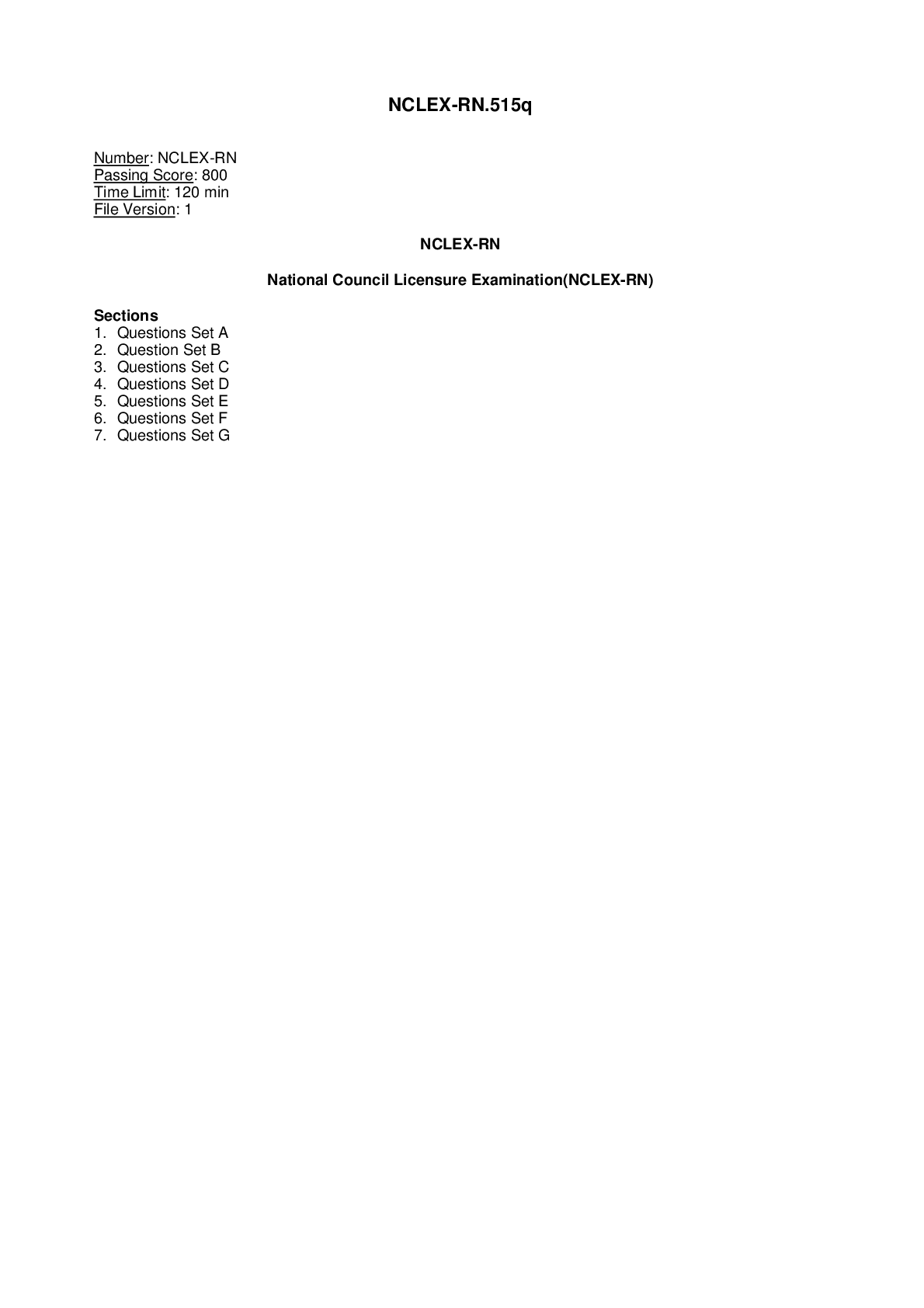Sections
1. Questions Set A
2. Question Set B
3. Questions Set C
4. Questions Set D
5. Questions Set E
6. Questions Set F
7. Questions Set G
Exam A
QUESTION 1
To appropriately monitor therapy and client progress, the nurse should be aware that increased myocardial
work and O2 demand will occur with which of the following?
A. Positive inotropic therapy
B. Negative chronotropic therapy
C. Increase in balance of myocardial O2 supply and demand
D. Afterload reduction therapy
Correct Answer: A
Section: Questions Set A
Explanation
Explanation/Reference:
Explanation:
(A) Inotropic therapy will increase contractility, which will increase myocardial O2 demand. (B) Decreased
heart rate to the point of bradycardia will increase coronary artery filling time. This should be used
cautiously because tachycardia may be a compensatory mechanism to increase cardiac output. (C) The
goal in the care of the MI client with angina is to maintain a balance between myocardial O2 supply and
demand. (D) Decrease in systemic vascular resistance by drug therapy, such as IV nitroglycerin or
nitroprusside, or intra-aortic balloon pump therapy, would decrease myocardial work and O2 demand.
QUESTION 2
The nurse would need to monitor the serum glucose levels of a client receiving which of the following
medications, owing to its effects on glycogenolysis and insulin release?
A. Norepinephrine (Levophed)
B. Dobutamine (Dobutrex)
C. Propranolol (Inderal)
D. Epinephrine (Adrenalin)
Correct Answer: D
Section: Questions Set A
Explanation
Explanation/Reference:
Explanation:
(A) Norepinephrine’s side effects are primarily related to safe, effective care environment and include
decreased peripheral perfusion and bradycardia. (B) Dobutamine’s side effects include increased heart
rate and blood pressure, ventricular ectopy, nausea, and headache. (C) Propranolol’s side effects include
elevated blood urea nitrogen, serum transaminase, alkaline phosphatase, and lactic dehydrogenase. (D)
Epinephrine increases serum glucose levels by increasing glycogenolysis and inhibiting insulin release.
Prolonged use can elevate serum lactate levels, leading to metabolic acidosis, increased urinary
catecholamines, false elevation of blood urea nitrogen, and decreased coagulation time.
QUESTION 3
Which of the following medications requires close observation for bronchospasm in the client with chronic
obstructive pulmonary disease or asthma?
A. Verapamil (Isoptin)
B. Amrinone (Inocor)
C. Epinephrine (Adrenalin)
D. Propranolol (Inderal)
Correct Answer: D
Section: Questions Set A
Explanation
Explanation/Reference:
Explanation:
(A) Verapamil has the respiratory side effect of nasal or chest congestion, dyspnea, shortness of breath
(SOB), and wheezing. (B) Amrinone has the effect of increased contractility and dilation of the vascular
smooth muscle. It has no noted respiratory side effects. (C) Epinephrine has the effect of bronchodilation
through β stimulation. (D) Propranolol, esmolol, and labetalol are all β- blocking agents, which can increase
airway resistance and cause bronchospasms.
QUESTION 4
The following medications were noted on review of the client’s home medication profile. Which of the
medications would most likely potentiate or elevate serum digoxin levels?
A. KCl
B. Thyroid agents
C. Quinidine
D. Theophylline
Correct Answer: C
Section: Questions Set A
Explanation
Explanation/Reference:
Explanation:
(A) Hypokalemia can cause digoxin toxicity. Administration of KCl would prevent this. (B) Thyroid agents
decrease digoxin levels. (C) Quinidine increases digoxin levels dramatically. (D) Theophylline is not noted
to have an effect on digoxin levels.
QUESTION 5
In the client with a diagnosis of coronary artery disease, the nurse would anticipate the complication of
bradycardia with occlusion of which coronary artery?
A. Right coronary artery
B. Left main coronary artery
C. Circumflex coronary artery
D. Left anterior descending coronary artery
Correct Answer: A
Section: Questions Set A
Explanation
Explanation/Reference:
Explanation:
(A) Sinus bradycardia and atrioventricular (AV) heart block are usually a result of right coronary artery
occlusion. The right coronary artery perfuses the sinoatrial and AV nodes in mostindividuals. (B) Occlusion
of the left main coronary artery causes bundle branch blocks and premature ventricular contractions. (C)
Occlusion of the circumflex artery does not cause bradycardia. (D) Sinus tachycardia occurs primarily with
left anterior descending coronary artery occlusion because this form of occlusion impairs left ventricular
function.
QUESTION 6
When inspecting a cardiovascular client, the nurse notes that he needs to sit upright to breathe. This
behavior is most indicative of:
A. Pericarditis
B. Anxiety
C. Congestive heart failure
D. Angina
Correct Answer: C
Section: Questions Set A
Explanation
Explanation/Reference:
Explanation:
(A) Pericarditis can cause dyspnea but primarily causes chest pain. (B) Anxiety can cause dyspnea
resulting in SOB, yet it is not typically influenced by degree of head elevation. (C) The inability to oxygenate
well without being upright is most indicative of congestive heart failure, due to alveolar drowning. (D)
Angina causes primarily chest pain; any SOB associated with angina is not influenced by body position.
Read More


